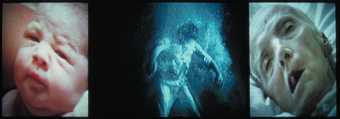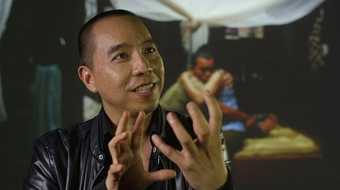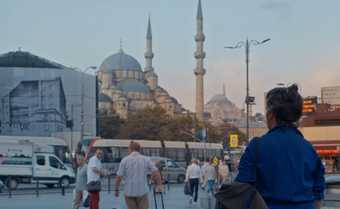The representation of my artwork is usually a combination of video installation, painting, drawings and sculptures.
They are my reflections on the history of Vietnam and also my observation on the poetry of daily life.
I was initially trained as a painter but I am very interested in the idea of history as fiction, the modern architecture movement in Vietnam and Cambodia and also about the Mekong river and its relationship to folklore in this region.
The Mekong river is one of the largest rivers in the world and for me this river is so important in terms of culture, history and economy. In recent decades, from my observation, the river has been heavily impacted by environmental changes, natural and annual flooding in the Mekong delta brings a lot of nutrition and alluvium from the river to nurture the land but in recent decades for agricultural development a very sophisticated system of dykes are built in order to prevent flood water from coming inside the rice paddies.
Over the years because the land cannot get natural water from the river it becomes polluted by all of the chemicals and the pesticides that are heavily used for agricultural production.
Art can have a significant impact on how we perceive the living environment.
First Rain, Brise Soleil is my exploration on the relationship between Vietnam and Cambodia. The 'first rain' of the monsoon season begins the rice cultivation cycle, very important to us culturally, and 'brise soleil' on the other hand is a concrete structure with holes on them.
I compared these two elements, the memory of a Vietnamese construction worker and also the destruction of one of the most iconic modernist buildings in Phnom Penh, the Bassac Theatre, and the second part of the video is based on a folktale about a love story between a Vietnamese man and a Cambodian woman.
I'm very interested in the idea between truth and fiction but growing up in Vietnam I feel like the official history that I perceive or study in school is very manipulated, the literature that I receive is also very limited.
I can easily access folk stories from the West but the folk traditions from the neighbouring countries are almost invisible so I kind of turned towards the idea of using folklore and mythologies also fairy tales in order to kind of seeking for alternatives of truth.
I don't really expect that the audience have to have all of the knowledge about the research that I did in order to make the artwork.
What is important for me and what has attracted me to become an artist is the ability of the visual art to connect us.
In my work No Jute Cloth for the Bones bodies interact with the jute in order to create sound and this sound is somehow for me the lullaby for the lost life in the famine but the audience doesn't have to know all of these things they can just enjoy and experience the environment.
At the Fine Art University in Saigon I was trained as lacquer artist but I really like to use the medium of silk because of its transparency, so in Dream of March and August all of the paintings are paired in diptychs and they are hung next to each other and they are put in a translucent frame so you can walk around the paintings and see both the front and the back of the paintings.
Mute Grain is a three-channel video installation in black and white and the video is my personal exploration of the historic event of the famine in the Red River Delta of Vietnam during the Japanese occupation which believed to cause the death of two million Vietnamese people.
Because this particular event is not well recorded in standard history I was very curious and I wonder why certain events in history are glorified, why other events are not mentioned at all.
What I feel important is the beauty and the poetry of the artwork give a universal way of being connected and overcome all of the historical trauma.
Personally I think in Vietnam we like to think and talk about the future because we are very optimistic and as a generation that was born after the reformation period and long after the Vietnam War we think that the hardship was over but somehow personally as an artist I think it is a dangerous optimism because with this optimism we kind of sacrifice nature, sacrifice the environment and sacrifice heritage in order to seek for new ideas about consumerism or capitalism.
I like to propose an alternative to progress and to modernity that is not destructive but it is more like an embrace learned from the value of the past study in order to have sustainable future.
Through video, paintings and sculpture, Phan explores the historical and ecological issues facing her homeland Vietnam, while speaking to broader ideas around tradition, ideology, ritual and environmental change.
Her recent projects have expanded on ‘the beauty and suffering’ of the Mekong River, which runs through Tibet, China, Myanmar, Thailand, Laos and Cambodia before meeting the sea on the coast of Vietnam.
Phan’s latest moving image work First Rain, Brise Soleil continues this exploration of the Mekong, proposing a new way of being that draws on indigenous knowledge and respect for the ecosystem.



